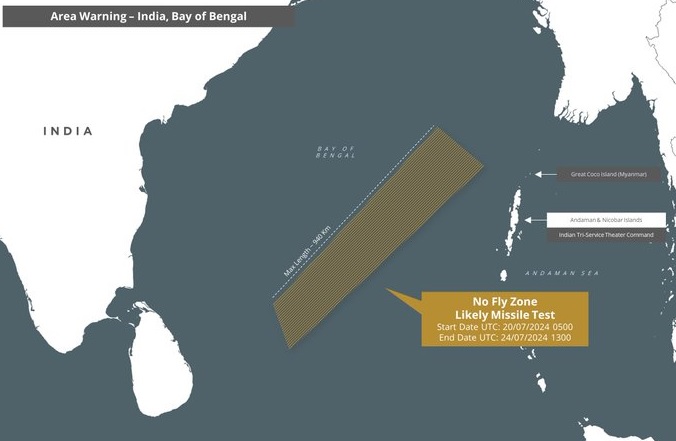India Declares No-Fly Zone Over Bay of Bengal for Major Missile Test from July 20-24

India has taken a significant step in its defense strategy by declaring a no-fly zone over a massive 940-kilometer stretch of the Bay of Bengal. This restriction, in place from July 20th to 24th, 2024, hints at an upcoming missile test of considerable importance. The vast scale of the no-fly zone suggests that the test involves a long-range missile system, potentially launched from a ship. Speculation is rife that the missile in question could either be a BrahMos or a sub-sonic cruise missile, both of which are key components of India's missile arsenal.
The BrahMos missile, a product of a joint venture between India and Russia, is renowned for its supersonic speed and precision. It has been successfully tested and deployed by the Indian armed forces in various configurations, including land-based, ship-launched, and even air-launched versions. The BrahMos missile system is considered one of the fastest cruise missiles in the world, capable of traveling at speeds of up to Mach 3. Its versatility and effectiveness make it a critical asset in India's defense strategy.
While the exact details of the upcoming test remain under wraps, the no-fly zone declaration by the Indian Navy is a clear indicator of the strategic importance of this test. Mariners and aircraft have been advised to avoid the specified area to ensure safety during the test period. This advisory underscores the potential scale and impact of the missile test.
India's missile development program has made significant strides in recent years. The successful development and deployment of the BrahMos missile are a testament to India's growing technological prowess and defense capabilities. This upcoming test is expected to provide valuable insights into the advancements made in India's missile technology and its readiness to counter potential threats.
The Indian Navy, tasked with conducting the test, plays a pivotal role in ensuring the nation's maritime security. By executing such tests, the Navy not only evaluates the performance of its missile systems but also demonstrates India's capability to defend its interests in the region. The Bay of Bengal, a strategically important region, serves as an ideal location for such tests due to its vast expanse and relative isolation from densely populated areas.
As the test date approaches, anticipation and curiosity are building among defense analysts and enthusiasts. The outcome of this test could have far-reaching implications for India's defense strategy and its position in the global defense landscape. Successful completion of the test would reaffirm India's commitment to enhancing its defense capabilities and maintaining a robust deterrence posture.
In summary, India's declaration of a no-fly zone over the Bay of Bengal from July 20th to 24th, 2024, marks a significant event in the nation's defense calendar. The upcoming missile test, shrouded in secrecy yet laden with strategic importance, is poised to showcase India's technological advancements and bolster its defense preparedness. As the nation awaits the test's results, the world watches with keen interest, recognizing the broader implications of India's growing missile capabilities.


